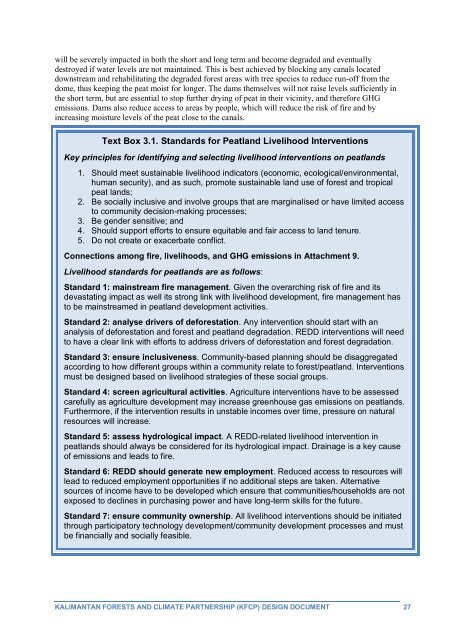Kalimantan Forests and Climate Partnership (KFCP) Design ...
Kalimantan Forests and Climate Partnership (KFCP) Design ...
Kalimantan Forests and Climate Partnership (KFCP) Design ...
You also want an ePaper? Increase the reach of your titles
YUMPU automatically turns print PDFs into web optimized ePapers that Google loves.
will be severely impacted in both the short <strong>and</strong> long term <strong>and</strong> become degraded <strong>and</strong> eventually<br />
destroyed if water levels are not maintained. This is best achieved by blocking any canals located<br />
downstream <strong>and</strong> rehabilitating the degraded forest areas with tree species to reduce run-off from the<br />
dome, thus keeping the peat moist for longer. The dams themselves will not raise levels sufficiently in<br />
the short term, but are essential to stop further drying of peat in their vicinity, <strong>and</strong> therefore GHG<br />
emissions. Dams also reduce access to areas by people, which will reduce the risk of fire <strong>and</strong> by<br />
increasing moisture levels of the peat close to the canals.<br />
Text Box 3.1. St<strong>and</strong>ards for Peatl<strong>and</strong> Livelihood Interventions<br />
Key principles for identifying <strong>and</strong> selecting livelihood interventions on peatl<strong>and</strong>s<br />
1. Should meet sustainable livelihood indicators (economic, ecological/environmental,<br />
human security), <strong>and</strong> as such, promote sustainable l<strong>and</strong> use of forest <strong>and</strong> tropical<br />
peat l<strong>and</strong>s;<br />
2. Be socially inclusive <strong>and</strong> involve groups that are marginalised or have limited access<br />
to community decision-making processes;<br />
3. Be gender sensitive; <strong>and</strong><br />
4. Should support efforts to ensure equitable <strong>and</strong> fair access to l<strong>and</strong> tenure.<br />
5. Do not create or exacerbate conflict.<br />
Connections among fire, livelihoods, <strong>and</strong> GHG emissions in Attachment 9.<br />
Livelihood st<strong>and</strong>ards for peatl<strong>and</strong>s are as follows:<br />
St<strong>and</strong>ard 1: mainstream fire management. Given the overarching risk of fire <strong>and</strong> its<br />
devastating impact as well its strong link with livelihood development, fire management has<br />
to be mainstreamed in peatl<strong>and</strong> development activities.<br />
St<strong>and</strong>ard 2: analyse drivers of deforestation. Any intervention should start with an<br />
analysis of deforestation <strong>and</strong> forest <strong>and</strong> peatl<strong>and</strong> degradation. REDD interventions will need<br />
to have a clear link with efforts to address drivers of deforestation <strong>and</strong> forest degradation.<br />
St<strong>and</strong>ard 3: ensure inclusiveness. Community-based planning should be disaggregated<br />
according to how different groups within a community relate to forest/peatl<strong>and</strong>. Interventions<br />
must be designed based on livelihood strategies of these social groups.<br />
St<strong>and</strong>ard 4: screen agricultural activities. Agriculture interventions have to be assessed<br />
carefully as agriculture development may increase greenhouse gas emissions on peatl<strong>and</strong>s.<br />
Furthermore, if the intervention results in unstable incomes over time, pressure on natural<br />
resources will increase.<br />
St<strong>and</strong>ard 5: assess hydrological impact. A REDD-related livelihood intervention in<br />
peatl<strong>and</strong>s should always be considered for its hydrological impact. Drainage is a key cause<br />
of emissions <strong>and</strong> leads to fire.<br />
St<strong>and</strong>ard 6: REDD should generate new employment. Reduced access to resources will<br />
lead to reduced employment opportunities if no additional steps are taken. Alternative<br />
sources of income have to be developed which ensure that communities/households are not<br />
exposed to declines in purchasing power <strong>and</strong> have long-term skills for the future.<br />
St<strong>and</strong>ard 7: ensure community ownership. All livelihood interventions should be initiated<br />
through participatory technology development/community development processes <strong>and</strong> must<br />
be financially <strong>and</strong> socially feasible.<br />
KALIMANTAN FORESTS AND CLIMATE PARTNERSHIP (<strong>KFCP</strong>) DESIGN DOCUMENT 27

















